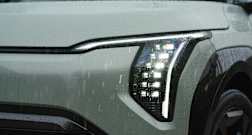A game-changing electric car technology is one step closer to coming to your home.
Mitsubishi Australia has been approved for bi-directional charging at its Adelaide headquarters.
Bi-directional charging is the process of sending power back to the grid or powering your home via the battery of an electric car.
-
2024 Mitsubishi Outlander PHEV adds new GSR model to mid-size SUV line-up to take on Toyota RAV4 Hybrid and Nissan X-Trail e-Power
-
Outlander is the new black! Upgraded 2024 Mitsubishi Outlander taking the mid-size SUV fight to Hyundai Tucson, Nissan X-Trail and Toyota RAV4
-
Mitsubishi Australia's popularity is dropping, but can the new 2024 Triton ute and hybrid Outlander halt its downward trajectory?
This would allow owners to charge their vehicle with rooftop solar power during the day and then to power their home for free at night.
It can also be used during blackouts or feed energy back to the grid during peak periods.
An electric car battery stores a massive amount of energy capable of holding anywhere from about 50kWh to more than 100kWh depending on the model. For comparison, Tesla’s Powerwall home battery stores 13.5kWh.
Mitsubishi has installed two Jet Charge bi-directional charging stations at its HQ and has been approved to send power back to the grid from its Outlander and Eclipse Cross plug-in hybrids.
Plug-in hybrids have a much smaller battery than full electric cars – the Outlander PHEV has a 20kWh item – but generally have a higher capacity than a home battery.
Jet Charge boss Tim Washington said the different parts of the industry need to work together to deliver this technology.
“Bi-directional charging will fundamentally change how we view transport and energy. It will make our vehicles an even bigger part of our everyday lives, powering how we move and how we live,” he said.

The widespread use of the technology has been caught up in government red tape and only the South Australian government has approved small applications of the technology.
There have been ongoing trials in South Australia for about 18 months.
Winemaker Joseph Evans installed the technology back in 2022 as part of the trial.
“I’ve gone from a $6000 annual power bill to making around $50 per week in profit selling my excess power back to the grid,” he said in 2022.
Evans installed rooftop solar on his property and then used his Nissan Leaf electric car to power the property during dark hours.
Not every electric car is set-up to be able to convert the DC energy stored in the electric car’s battery back to AC electricity that is running through the grid, though.
Nissan and Mitsubishi are two of the carmakers who have future-proofed their electrified vehicles.
Hyundai and Kia electric cars can power household appliances and tools with their vehicle-to-load function. The cars have a regular household powerpoint in the car that you can plug into.










.jpg)

.jpg)

.jpg)





.jpg)


.jpg)


.jpg)